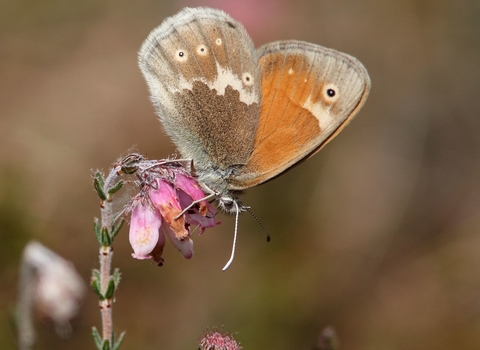
Stefan Johansson

Large heath © Brian Eversham

Large heath © Pete Richman

Large heath © Pete Richman
Large heath
This bog-loving butterfly is mostly found in the north of the UK, where it takes to the wing in summer.
Enw gwyddonol
Coenonympha tulliaPryd i'w gweld
June to AugustGwybodaeth am rywogaethau
Ynghylch
Large heaths are very picky about where they live. They are restricted to bogs and damp moorland, where there are flat wetland areas full of their caterpillar's foodplant. This is usually hare's-tail cottongrass, but they will also feed on common cottongrass and jointed rush.Adults fly between June and August, though the exact flight period depends on the location. Butterflies further north, or at higher altitudes, emerge later in summer than those to the south or at lower altitudes. They can be seen flying on warm days, even in dull weather as long as the air temperature is higher than 14ºC. Males tend to be more active than females, but both sexes visit plants to feed on nectar. One of their favourite nectar sources is cross-leaved heath, which often grows close to their food plants. Unlike most butterflies, large heaths always rest with their wings closed.
Females lay spherical, pale yellow eggs on the foodplant — eggs are laid singly, often on dead stems at the plant's base. They hatch after around two weeks and the caterpillars feed on the leaves until September, when they hide low down in the vegetation and hibernate. They become active again in March, when they continue feeding until they're ready to pupate in April or May.
Large heaths live in distinct colonies. Local populations can be huge, with up to 15,000 butterflies — though they are usually much smaller than this. They rarely fly more than a few hundred metres from where they emerged, which means it's easy for colonies to become isolated from each other and vulnerable. They have been lost from many parts of the UK as peatland habitats have been drained or otherwise damaged.
Sut i'w hadnabod
A small, orange-brown butterfly that always rests with its wings closed. On the underside of the wings is a series of pale-bordered black spots with white dots in the centre. These spots vary across the large heath's range. Those in the north of Scotland are almost spotless, whilst in some parts of England they have large and very obvious spots. Butterflies in other parts of the UK have spots that are intermediate between these two forms.Caterpillars are green with darker green and white or yellowish stripes running the length of the body. They have two pink points at the rear of the body.
